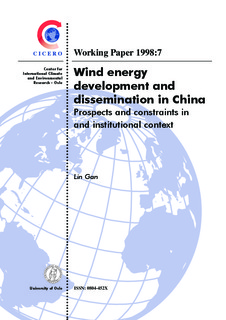| dc.contributor.author | Gan, Lin | nb_NO |
| dc.date.accessioned | 2014-03-17T14:31:39Z | |
| dc.date.available | 2014-03-17T14:31:39Z | |
| dc.date.issued | 1998 | nb_NO |
| dc.identifier.issn | 0504-452X | nb_NO |
| dc.identifier.uri | http://hdl.handle.net/11250/192462 | |
| dc.description.abstract | This study is intended to provide a better understanding of the functional roles and dynamics of institutions in determining the effectiveness of national and regional public-sector initiatives to promote the dissemination of wind turbine technologies in China. The structures, roles, and relationships of relevant institutions involved in wind energy development are analyzed. It examines wind energy development in the last four decades and divides them into four different stages of development.
The objective of the study is to identify the steering mechanisms in wind-energy technology dissemination, and the obstacles involved. It is argued that institutional problems constitute major barriers for cost-effective development of wind turbines in China. These include investment loans, tax systems, electricity prices, technology transfer and adaptation, and human resources development.
Two empirical studies about the Inner Mongolia region and the Dachen Island in Zhejiang Province are presented as illustrative cases. It concludes that establishing stable frameworks for private sector participation in the wind-energy market holds the key for effective dissemination of wind turbine technologies in China. | nb_NO |
| dc.language.iso | eng | nb_NO |
| dc.publisher | CICERO Center for International Climate and Environmental Research - Oslo | nb_NO |
| dc.relation.ispartof | CICERO Working Paper | nb_NO |
| dc.relation.ispartofseries | CICERO Working Paper;1998:07 | nb_NO |
| dc.title | Wind energy development and dissemination in China: Prospects and constraints in an institutional context | nb_NO |
| dc.type | Working paper | nb_NO |
| dc.source.pagenumber | | nb_NO |
